FDA VRBPAC Considers Pfizer COVID-19 Vaccine for Kids 5 – 11
Tagged:COVID
/
MathInTheNews
/
PharmaAndBiotech
/
Statistics
Today the FDA’s Vaccine and Related Biological Products Advisory Committee (VRBPAC) meets to discuss an Emergency Use Authorization (EUA) for Pfizer’s COVID-19 vaccine Comirnaty for children ages 5 – 11. Lots of parents have been awaiting this for the last year and a half, with varying degress of frayed nerves.
What’s the sitch?
Today we begin the 4-step process for getting an EUA for pediatric vaccines for children:
- The FDA’s VRBPAC committee of outside experts has to decide if the risk/benefit is favorable and recommend EUA to the FDA.
- The FDA administration has to say, “Yeah, right: let’s do that.” This is typically a couple days to a week after the VRBPAC meeting.
- The CDC’s ACIP committee of outside experts has to recommend to the CDC that this should be recommended medical practice in the US. That’s scheduled for next Tuesday, 2021-Nov-02.
- The CDC management has to say, “Ok, fine: that’s now the standard.”
Normally this takes months, maybe a year because people are really careful about stuff on which people will literally bet their lives. Lately, with the urgency of COVID-19 and this being an emergency use authorization and all, it’s instead been taking weeks. So this has been quite fast: somebody is frantically turning the crank really hard on machinery that was never meant to go this fast. So when they get things done, we should applaud them.
If everything goes smoothly, vaccinations of kids 5 – 11 could start Wednesday 2021-Nov-03.
Today is step 1.
Our trusty safari guides
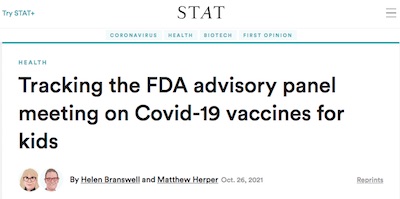 As has apparently become the pandemic custom of this crummy little blog that nobody reads,
we will rely upon the formidable Helen Branswell and Matthew Herper of STAT News to be
our guides on this safari. [1] They’re live-blogging the
whole thing, and we’ll tag along with them to get a couple extra pairs of eyes to point out the
more interesting sights along the way.
As has apparently become the pandemic custom of this crummy little blog that nobody reads,
we will rely upon the formidable Helen Branswell and Matthew Herper of STAT News to be
our guides on this safari. [1] They’re live-blogging the
whole thing, and we’ll tag along with them to get a couple extra pairs of eyes to point out the
more interesting sights along the way.
They’ve already done us one favor in their preamble, pointing out that there was an organized campaign of anti-vaxxers trying to lobby the VRBPAC members with mass emails to stop the vaccine in its tracks:
Members of the the Vaccines and Related Biological Products Advisory Committee (VRBPAC) were deluged by an organized email campaign urging them not to recommend the vaccine.
“Over the weekend I was getting about one email every minute,” said VRBPAC member Paul Offit, a vaccines expert at Children’s Hospital of Philadelphia, who said by the time the weekend was over he had received “hundreds and hundreds.”
Scott Siskind once said, “I have only done a little bit of social science research, but it was enough to make me hate people.” [2] It’s at moments like this that I sympathize with this view, when people deliberately try to sabotage public health.
For today, Pfizer tested doses of 10μg, 20μg, and 30μg (the original dose for adults) in a dose-finding Phase 1 trial. They picked 10μg and are today applying for EUA for the 10μg dose ages 5 – 11 as tested in a Phase 2/3 trial, and sticking with the 30μg dose for 12 and older. Pfizer says that dose in ages 5 – 11 a vaccine efficacy (i.e., reduction in probability of infection compared to unvaccinated) of 91%. As historical vaccines go, that’s excellent. The issues will likely be (a) medical need, and (b) side effects in otherwise healthy children who aren’t at huge COVID-19 risk anyway. Let’s hope the latter are just headache and mild fever.
They compared 1518 kids in the treatment arm (3 got COVID-19) vs 750 in the placebo arm (16 got COVID-19), so it should be adequately powered to see reasonably-sized effects (but not rare events, like rare adverse events such as anaphylaxis).
Just a guess based on the numbers in each arm: I bet they did 2:1 randomization into the treatment vs placebo arms. In fact, just from those 4 integers, we can do our own little prediction of what they’ll report for vaccine efficacy:
\[\begin{align*} \mbox{VE} &= 100\% \times \left(1 - \frac{\Pr\left(\mbox{infect} | \mbox{treatment}\right)}{\Pr\left(\mbox{infect} | \mbox{placebo}\right)}\right) \\ &= 100\% \times \left(1 - \frac{3/1518}{16/750}\right) \\ &= 100\% \times \left(1 - \frac{0.00198}{0.0213}\right) \\ &= 100\% \times \left(1 - 0.0930\right) \\ &= 90.7\% \sim 91\% \end{align*}\]We can also get a (very crude) estimate of the 95% confidence limits, using a scaled binomial model like the one we used on the Israeli Simpson Paradox dataset:
> library("gsDesign")
Loading required package: xtable
Loading required package: ggplot2
> NtrtInf <- 3
> NcntInf <- 16
> Ntrt <- 1518
> Ncnt <- 750
> 100.0 * (1 - rev(ciBinomial(NtrtInf, NcntInf, Ntrt, Ncnt, scale = "RR")))
upper lower
1 70.3731 97.10647
Prediction: We predict they will report 90.7% vaccine efficacy, with a 95% confidence limit of 70.4% – 97.1%, at least at a very naïve level (their confidence limit algorithm will be more sophisticated than this clunky one, and will take into account censorship effects as people drop out of the trial).
Better still, the vax kids had mild symptoms but the unvaxed kids had more pronounced fevers and other symptoms. So, overall pretty good.
The data sources
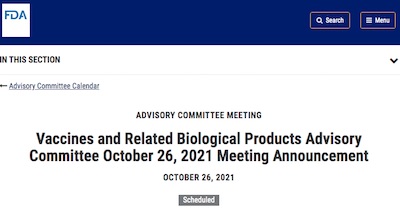
Of course we won’t rely entirely on our safari guides, experienced as they are. We’ll also examine, perhaps superficially, the primary data sources from the FDA. The meeting announcement page [3] also has on it pointers to all the meeting presentations that the VRBPAC will consider. For completists and obsessives, all 7 or 8 hours of the hearings are livestreamed, and can be watched on YouTube as seen here.
The agenda for the meeting (revised, for some reason) [4] contains pretty much the things you’d expect:
- welcomes and introduction to the topic & background,
- CDC presentations on epidemiology and safety signals like myocarditis,
- a Pfizer presentation analyzing their data,
- an FDA presentation independently analyzing the same data,
- some FDA surveys of post-authorization safety data and benefit/risk analysis,
- the usual open public hearing to let in the craziness,
- Q&A, discussion, and voting.
The discussion question that is supposed to determine what the committee recommends to the FDA is [5]:
October 26, 2021 VRBPAC Meeting Voting Question
Based on the totality of scientific evidence available, do the benefits of the PfizerBioNTech COVID-19 Vaccine when administered as a 2-dose series (10 µg each dose, 3 weeks apart) outweigh its risks for use in children 5 – 11 years of age?
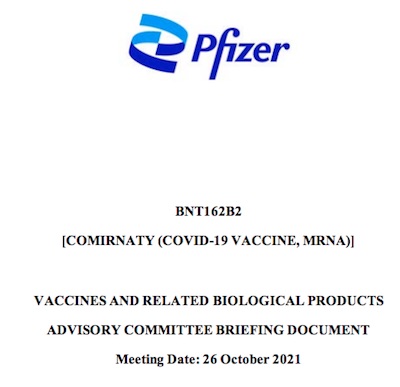

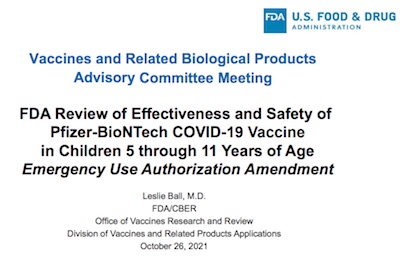
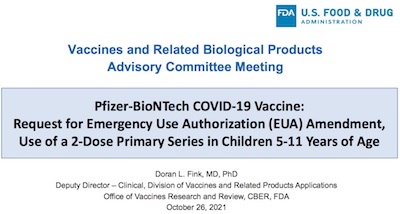
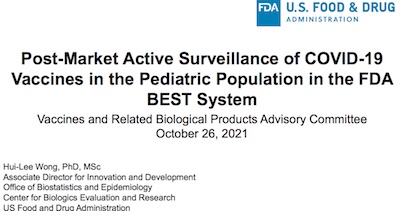
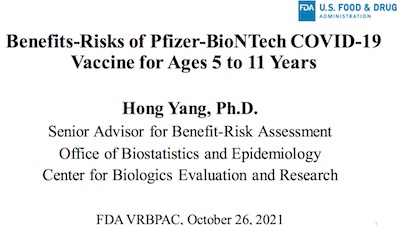
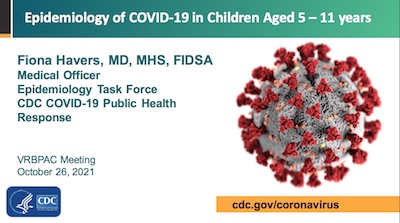
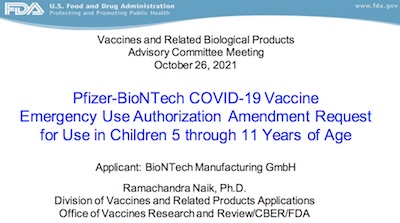
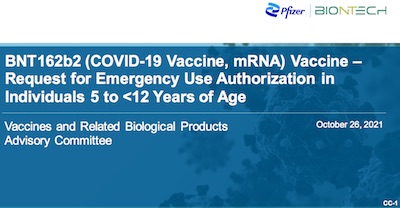
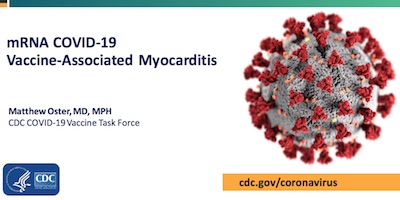 There are 10 documents to review here:
There are 10 documents to review here:
- Ramachandra Naik of the FDA goes through the status of available vaccines, and what an EUA amendment would mean, then outlines the day’s agenda. [6]
- There is, of course, the Pfizer dossier. [7] It weighs in at 82 pages, which is what one of the documents the VRBPAC committee members have to digest beforehand. As previously, we’ll glance through it but prefer the slide package below for explanations and visual material.
- Then there’s the FDA’s dossier, which reanalyzes the same data to see if the FDA scientists get the same results. [8] Weighing in at 39 pages (Hey! See that? The government folk were briefer than the private sector folk.), we’ll again defer to the slide packages below.
- Next is a slide package from Leslie Ball of the FDA, reviewing the general background, study design, immunogenicity, efficacy, and safety of the pediatric trial. [9] This is more or less the FDA’s reanalysis, in slide form.
- Then Doran Fink of the FDA discusses the purpose of the meeting: background on COVID-19, background in kids 5 – 11, statutory criteria for an EUA, and what the benefit/risk considerations should be. [10]
- Hui-Lee Wong of the FDA discusses post-market active surveillance in the FDA’s BEST system, for tracking safety and effectiveness of biologics. [11]
- Hong Yang of the FDA considers the benefit-risk results for COVID-19 mRNA vaccination in children age 5 – 11. [12]
- Fiona Havers of the CDC discusses the epidemiology of COVID-19 in kids, presumably somewhat different from adults due to different immune systems and different life exposures. [13]
- WC Gruber of Pfizer presents their case for an EUA amendment. [14]
- Finally, Michael Oster of the CDC talks about mRNA COVID-19 vaccine-associated myocarditis in kids. [15] This will be interesting because it’s associated with (a) males and (b) youth; will it be a problem in younger boys?
The keynote set by the FDA CBER head
Matt Herper reports that Peter Marks, the head of FDA CBER, wanted to establish two facts for the VRBPAC:
- Unmet medical need: There is, in fact, significant harm to kids, especially from the Delta variant. In ages 5 – 11 there have been 1.9 million infections, 8300 hospitalizations (1/3 ICU admissions), 2500 cases of MIS-C (multisystem inflammatory syndrome in children; summary: you don’t want your kids to get it), and over 100 deaths. That makes COVID-19 one of the top 10 causes of death in ages 5 – 11 for this period. And of course, it has impacts on school closure.
- Mandates: Mandates are out of scope for this committee; other bodies will decide that. Just medical need, safety, and efficacy are on the table today.
Epidemiology and unmet medical need: does it happen often, and does it matter?
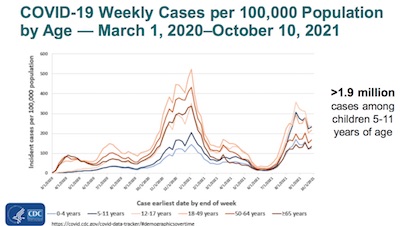
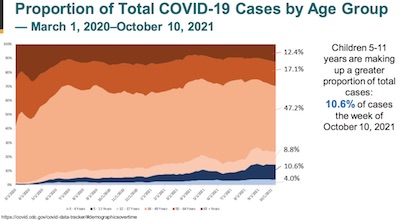
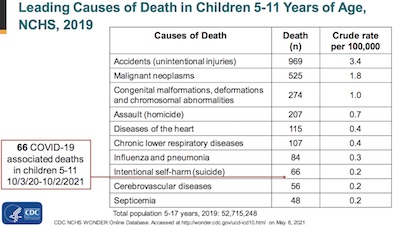 Fiona Havers of the CDC, in discussiong the epidemiology of COVID-19 in kids, confirms
much of this. The stratification by age indeed shows 1.9 million COVID-19 cases i ages
5 – 11. Empirically, seroprevalence in that age group hints that the actual rate is much
higher, so the cases are probably under-reported.
Fiona Havers of the CDC, in discussiong the epidemiology of COVID-19 in kids, confirms
much of this. The stratification by age indeed shows 1.9 million COVID-19 cases i ages
5 – 11. Empirically, seroprevalence in that age group hints that the actual rate is much
higher, so the cases are probably under-reported.
Kids ages 5 – 11 constituted 10.6% of the cases in the week of 2021-Oct-10, so it’s not a clinically rare thing at all!
Finally, she shows that COVID-19 is now the 8th leading cause of death of kids age 5 – 11.
I think we can now regard the case for epidemiological frequency and unmet medical need as having been established. Thoroughly.
Myocarditis safety signals
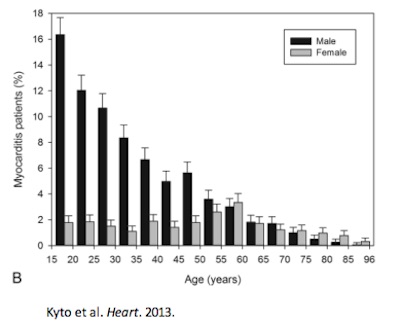
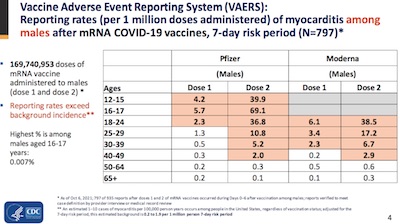 Matthew Ostler of the CDC is our guide: they’ve tracked case of myocarditis for 3-6
months. He’s got a lot of stuff here, but I took away 2 things:
Matthew Ostler of the CDC is our guide: they’ve tracked case of myocarditis for 3-6
months. He’s got a lot of stuff here, but I took away 2 things:
- Pre-COVID-19, myocarditis still happened. But it happened in males most of the time (e.g., 8x more often in 15-year-old boys than girls). Also, it declined rapidly with age, men and women reaching parity at about age 50. So the incidence in myocarditis in young males is not just a vaccine thing, it’s how the world was.
- The table shows the risk in men is a few parts per million or less (around tenths of a part per million), except in young males under 30 after the 2nd dose of an mRNA vaccine. (The corresponding table for women never shows a risk above a few parts per million.)
So the myocarditis risk is in a clearly identifiable population, that can be tracked by doctors and hospitals. (Though the threshold of age 30 vs age 50 for male/female parity before COVID is puzzling.) That’s good, because we can either (a) encourage them to get J&J, or (b) follow up with them for after vaccination. Elsewhere, Ostler shows the main risk is also quite time-bounded, around the first 5 days or so after the 2nd dose of mRNA vaccine.
It’s not ideal that this happens, but it’s in a population that medical people can identify and watch, and it’s a short period of time, and the inflammation usually resolves with treatment. So, not ideal, but we kind of know what to do about it. Plus, it’s a risk faced by young boys even before COVID-19 and before mRNA vaccines.
Finally, apparently the theory is that all this has something to do with testosterone. So we should see less of it in young (pre-puberty) boys than in teenagers and young men. Not exactly a guarantee, but at least it’s a hint that the risk is lower for kids.
Risk-benefit analysis
Hong Yang is our guide here: she’s got models including how much COVID-19 spreads, vaccine-associated myocarditis risk, and overall vaccine efficacy. She compares risks associated with vaccination and then reduced risk of COVID-19 vs no vax risk from not being vaccinated but much higher COVID-19 risk (which causes worse myocarditis, anyway).
There’s a lot here, but the summary position is: vax risks are mild, COVID-19 risks are huge, and you’re way better off with vaccination. Especially if the risk of myocarditis is testosterone linked, then we should expect to see less of it in boys 5 – 11 years old.
Sounds like the truth to me!
The Pfizer presentation
Then we got to the main presentation by Pfizer, from William Gruber. They’re proposing a 10μg dose, intramuscular, as 2 doses 3 weeks apart just like the adult version. The main difference is the pediatric dose is 1/3 the adult dose.
Gruber confirmed that they did 2:1 randomization into the treatment and placebo arms of the Phase 2/3 part of the trial, so that explains the ~1500 : 750 numbers we speculated about above. They were followed for 6 months, with 3 blood draws to measure immunogenicity (baseline, 1 month, and 6 months).
The side effects were mostly fever, fatigue, and headache – about what we’d expect. There were SAEs reported, and were mostly what you’d also expect. Interestingly, they also reported “upper arm fracture” and “ingestion of a foreign body” (apparently a 5-year-old swallowed a penny, which has been known to happen…): stuff that happens to kids, but unlikely to be vaccine related. Remember in the Moderna trial, the guy who had to report being struck by lightning? Yeah, like that.
But there was no anaphylaxis, no myocarditis (phew!), no Bell’s palsy, etc.
They did “immunobridging” studies, to compare immunity between 5 – 11 year olds vs 16-25 year olds, and saw that the immunity was comparable.
It worked on both the reference strain and the Delta strain.
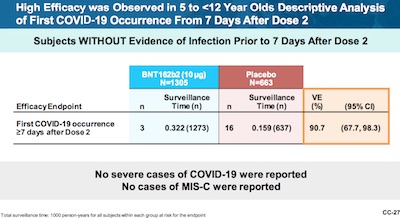
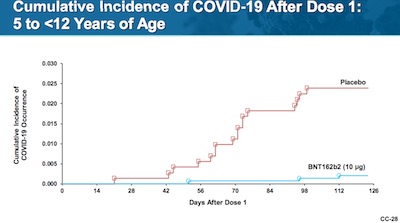 The main punchline we got out of it here at Chez Weekend was the vaccine efficacy: 90.7%
(spot on with the quick hack we did above to guess the point estimate of the efficacy!),
and with a 95% confidence limit of 67.7% – 98.3% (only slightly wider than our
estimate above of 70.4% – 97.1%). The confidence interval is much wider than the
original clinical trial because of the number of subjects enrolled: about 2250 here, vs about
30,000 in the first trial. That’s typical once you know a medication is working in one
population, to bridge to another population you don’t need to re-establish a tight
confidence interval (just safety, and some notion of comparable efficacy).
The main punchline we got out of it here at Chez Weekend was the vaccine efficacy: 90.7%
(spot on with the quick hack we did above to guess the point estimate of the efficacy!),
and with a 95% confidence limit of 67.7% – 98.3% (only slightly wider than our
estimate above of 70.4% – 97.1%). The confidence interval is much wider than the
original clinical trial because of the number of subjects enrolled: about 2250 here, vs about
30,000 in the first trial. That’s typical once you know a medication is working in one
population, to bridge to another population you don’t need to re-establish a tight
confidence interval (just safety, and some notion of comparable efficacy).
The corresponding Kaplan-Meier curves, shown here, are a thing of beauty just like the original clinical trial. (About which Randall Monroe cartooned in XKCD #2400 – “Statistics Pro Tip: Always try to get data that’s good enough that you don’t need to do statistics to it.”) The red curve shows infections vs time in the placebo arm; the blue curve shows infections vs time in the vaccine arm. Clearly, the vaccine is working and you don’t need a fancy statistician to tell you that! (Though, as it happens, one just did.)
So, yeah… another tour de force for mRNA vaccines.
The FDA presentations
Leslie Ball presented on the general background, study design, immunogenicity, efficacy, and safety of the pediatric trial. My quick look through these slides showed near-complete agreement with Pfizer, right down to 3 decimal place agreement in the vaccine efficacy calculation. This is what you generally hope for: the FDA reanalyzes your raw data according to the clinical trial protocol, and throws a fit if they disagree with your analysis.
No fits thrown here. Good.
Hui-Lee Wong presented on the pharmacovigilance programs, especially the FDA’s BEST system for tracking events in bilogicals, showing how well it worked in the adult dataset, how it tracked adverse events in about 1/3 of the US population, and so on. A red flag here would have been a disaster.
No red flags thrown down on the field here. Good.
Public comment period
It was the usual cesspool of paranoia and ignorance. I couldn’t bear more than a few sentences of it.
The vote
The committee wanted to argue with the FDA about the wording of the question. It was clear that a “no” vote would mean no kids could get the vaccine. They were less clear about whether a “yes” vote would lead to mandates, despite being told earlier that mandates are off topic for this meeting, and will be decided elsewhere (possibly at the CDC ACIP meeting next week?).
They pushed on this a couple of times, but Peter Marks of FDA/CBER more or less insisted on the question as worded. I’m not sure who’s side I would take here; I just want to see the pediatric vaccine move forward!
At 4:16pm, they voted: 17 Yes, 0 No, and 1 Abstain.
So it’s recommended to the FDA administrators for approval.
But what was the abstention about?
According to Helen Branswell, it was Michael Kurilla. Recall we previously noted that he abstained during the original Moderna approval hearing. In that case, he thought the EUA was a bit much, preferring an “extended access protocol” which would have opened the clinical trial to people at high risk, but not given broad access to the vaccine. Seems like a bad idea to me, but at least he’s consistent. (I don’t know if he was on the original Pfizer committee, because there was 1 abstention there, too.)
 Interestingly, Kurilla also argued against the need for a mix-and-match EUA,
saying it wasn’t necessary.
Interestingly, Kurilla also argued against the need for a mix-and-match EUA,
saying it wasn’t necessary.
Hmpf.
The Weekend Conclusion
So the Pfizer vaccine (“Comirnaty”, I hate that name) is now successfully past the first hurdle: the VRBPAC has recommended pediatric EUA status to the FDA administrators. The remaining 3 steps are:
- The FDA administrators have to agree, which looks very likely to happen.
- The CDC’s ACIP committee, which meets 7 days from now, has to recommend to the CDC that pediatric vaccination with Pfizer should be standard practice.
- The CDC administrators have to agree and make the recommendation.
So far, the data looks excellent on both the safety and efficacy front, so if there’s going to be any problem I can’t see it from here. (Other than: I wish this whole process were faster?!)
Looks like you’ll soon be able to vaccinate your kids!
The things on the horizon I’d like to see moving faster:
- Similar pediatric approvals for Moderna and J&J.
- The last remaining age cohort: infant pediatric studies, i.e., ages 6 months up to 5 years, for all 3 vaccines. I believe these are still in clinical trials, but haven’t really checked.
- Full approval for Moderna and J&J, to put them on an even footing with Pfizer and tamp down a bit on the paranoia and superstition of the resisters.
But for today… it looks like this was a good day.
Addendum 2021-Oct-29: FDA authorization
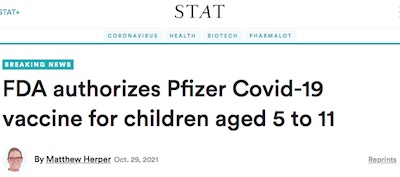
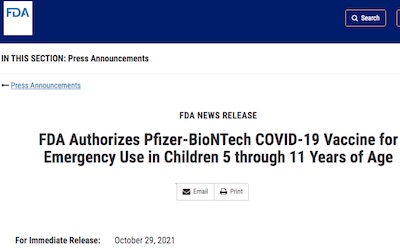 Today the FDA adminitrators took another of the steps above, and granted formal EUA for
Pfizer’s Comirnaty in 5 – 11
year olds. [16] [17]
Today the FDA adminitrators took another of the steps above, and granted formal EUA for
Pfizer’s Comirnaty in 5 – 11
year olds. [16] [17]
Both STAT News and the FDA press release quoted Woodcock:
“As a mother and a physician, I know that parents, caregivers, school staff, and children have been waiting for today’s authorization. Vaccinating younger children against COVID-19 will bring us closer to returning to a sense of normalcy,” said Acting FDA Commissioner Janet Woodcock, M.D. “Our comprehensive and rigorous evaluation of the data pertaining to the vaccine’s safety and effectiveness should help assure parents and guardians that this vaccine meets our high standards.”
The FDA press release also notes a couple epidemiological facts:
- Kids 5 – 11 make up 39% of COVID-19 cases in those under 18 in the US.
- Those aren’t all mild cases, either: 8300 COVID-19 hospitalizations in kids 5 – 11 so
far. As of 2021-Oct-17:
- 691 of those 8300 cases under 18 are now dead, and
- 146 of those dying were kids 5 – 11.
Those 2 facts mean: today we’re biting a big chunk out of a real risk to our kids.
Interestingly, the FDA also authorized a manufacturing change for Pfizer. They can now incorporate Tris buffer, a commonly used buffer in many other approved medications, to maintain stable pH. This makes the vaccine’s cold chain requirements a bit less stringent, which should lessen the logistics headaches of getting it distributed everywhere.
The next step, as enumerated above, is the meeting of the ACIP committee of the CDC, occurs next Tuesday, 2021-Nov-02.
While the risk of myocarditis appears to be small here, this pediatric trial was not adequately powered (not enough subjects enrolled) to quantify rare events. If the theory that vaccine-associated myocarditis is linked to testosterone is correct, then it’s not an issue for pediatric use. Also, the FDA models indicate there would be fewer myocarditis hospitalizations with the vaccine than with the COVID-19 cases from no vaccine.
But on the other hand, given this small trial we really just don’t know for sure. If there’s one thing docs on regulatory boards hate, it’s not knowing for sure that they’re not actually harming people. That should be a subject of active debate next Tuesday at the ACIP meeting.
Addendum 2021-Nov-02: CDC ACIP meeting
Today the CDC’s ACIP committee met about Pfizer’s Comirnaty vaccine against COVID-19 for 5 – 11 year olds. It was approved unanimously, 14-0. [18] Helen Branswell documented the meeting in a massive 50-tweet thread on Twitter:
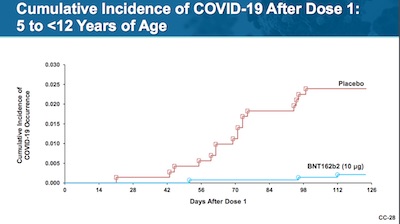 I won’t go over the presentations, as it appears there is no new data. If you’re
super-careful and curious, you can get all the presentations
here.
I won’t go over the presentations, as it appears there is no new data. If you’re
super-careful and curious, you can get all the presentations
here.
For my purposes, the only slide worth looking at is the one shown here, with the completely convincing Kaplan-Meier curves. I dunno why this was slide 28 of the Pfizer presentation; I almost want it to be the one and only slide of the whole meeting: “hey, anybody got an argument good enough to go up against this?”
(Yes, I am a cranky old man.)
There was, however, an increased emphasis on safety which is the main concern of ACIP anyway. There was a lot of discussion about myocarditis, but it is expected to be lower in the younger group than in men (perhaps testosterone-linked?). The risk of myocarditis from COVID-19 is much higher, in any case.
And as for schoolkids:
“These kids are not in a cocoon. They’re not at home,” said Norman Baylor, president and CEO of Biologics Consulting and a former head of the FDA’s Office of Vaccines. “These kids are in school and they are exposed to everything.”
Yep, that they are.
The next (and final!) step is formal administrative approval from the CDC director, Rochelle Walensky. Given that she described this as a “momentous day”, that is likely to happen fast.
Addendum 2021-Nov-02: CDC endorses ACIP recommendation
Well, that was fast [19]:
Today, CDC Director Rochelle P. Walensky, M.D., M.P.H., endorsed the CDC Advisory Committee on Immunization Practices’ (ACIP) recommendation that children 5 to 11 years old be vaccinated against COVID-19 with the Pfizer-BioNTech pediatric vaccine. CDC now expands vaccine recommendations to about 28 million children in the United States in this age group and allows providers to begin vaccinating them as soon as possible.
And in more personal terms, Walensky said:
“Together, with science leading the charge, we have taken another important step forward in our nation’s fight against the virus that causes COVID-19. We know millions of parents are eager to get their children vaccinated and with this decision, we now have recommended that about 28 million children receive a COVID-19 vaccine. As a mom, I encourage parents with questions to talk to their pediatrician, school nurse or local pharmacist to learn more about the vaccine and the importance of getting their children vaccinated.”
So that’s it: ages 5 – 11 vaccination with Pfizer is now on the table.
Get your kids vax’d!
Notes & References
1: H Branswell & M Herper, “Tracking the FDA advisory panel meeting on Covid-19 vaccines for kids”, STAT News, 2021-Oct-26. ↩
2: Scott Alexander Siskind, “LIZARDMAN’S CONSTANT IS 4%”, Slate Star Codex, 2013-Apr-12. ↩
3: FDA Staff, “Vaccines and Related Biological Products Advisory Committee October 26, 2021 Meeting Announcement”, FDA VRBPAC 2021-Oct-26 Materials, retrieved 2021-Oct-26. The meeting presentations are further down the page. ↩
4: FDA Staff, “170th Meeting of the Vaccines and Related Biological Products Advisory Committee October 26, 2021 DRAFT AGENDA (revised)”, FDA VRBPAC 2021-Oct-26 Materials, retrieved 2021-Oct-26. ↩
5: FDA Staff, “10/26 Discussion Question”, FDA VRBPAC 2021-Oct-26 Materials, retrieved 2021-Oct-26. ↩
6: R Naik, “Pfizer-BioNTech COVID-19 Vaccine Emergency Use Authorization Amendment Request for Use in Children 5 through 11 Years of Age”, FDA VRBPAC 2021-Oct-26 Materials, retrieved 2021-Oct-26. ↩
7: Pfizer staff, “BNT162B2 [COMIRNATY (COVID-19 VACCINE, MRNA)] VACCINES AND RELATED BIOLOGICAL PRODUCTS ADVISORY COMMITTEE BRIEFING DOCUMENT”, FDA VRBPAC 2021-Oct-26 Materials, retrieved 2021-Oct-26. ↩
8: FDA staff, “FDA Briefing Document: EUA amendment request for Pfizer-BioNTech COVID-19 Vaccine for use in children 5 through 11 years of age”, FDA VRBPAC 2021-Oct-26 Materials, retrieved 2021-Oct-26. ↩
9: L Ball, “FDA Review of Effectiveness and Safety of Pfizer-BioNTech COVID-19 Vaccine in Children 5 through 11 Years of Age Emergency Use Authorization Amendment”, FDA VRBPAC 2021-Oct-26 Materials, retrieved 2021-Oct-26. ↩
10: DL Fink, “Pfizer-BioNTech COVID-19 Vaccine: Request for Emergency Use Authorization (EUA) Amendment, Use of a 2-Dose Primary Series in Children 5 – 11 Years of Age”, FDA VRBPAC 2021-Oct-26 Materials, retrieved 2021-Oct-26. ↩
11: H-L Wong, “Post-Market Active Surveillance of COVID-19 Vaccines in the Pediatric Population in the FDA BEST System”, FDA VRBPAC 2021-Oct-26 Materials, retrieved 2021-Oct-26. ↩
12: H Yang, “Benefits-Risks of Pfizer-BioNTech COVID-19 Vaccine for Ages 5 to 11 Years”, FDA VRBPAC 2021-Oct-26 Materials, retrieved 2021-Oct-26. ↩
13: F Havers, “Epidemiology of COVID-19 in Children Aged 5 – 11 years”, FDA VRBPAC 2021-Oct-26 Materials, retrieved 2021-Oct-26. ↩
14: WC Gruber, “BNT162b2 (COVID-19 Vaccine, mRNA) Vaccine – Request for Emergency Use Authorization in Individuals 5 to <12 Years of Age”, FDA VRBPAC 2021-Oct-26 Materials, retrieved 2021-Oct-26. ↩
15: M Oster, “mRNA COVID-19 Vaccine-Associated Myocarditis”, FDA VRBPAC 2021-Oct-26 Materials, retrieved 2021-Oct-26. ↩
16: M Herper, “FDA authorizes Pfizer Covid-19 vaccine for children aged 5 to 11”, STAT News, 2021-Oct-29. ↩
17: FDA Office of Media Affairs, “FDA Authorizes Pfizer-BioNTech COVID-19 Vaccine for Emergency Use in Children 5 through 11 Years of Age”, US FDA press announcements, 2021-Oct-29. ↩
18: H Branswell, “CDC advisers endorse Pfizer’s Covid-19 vaccine for kids 5-11”, STAT News, 2021-Nov-02. ↩
19: CDC Media Relations, “CDC Recommends Pediatric COVID-19 Vaccine for Children 5 to 11 Years”, CDC Media Releases, 2021-Nov-02. ↩

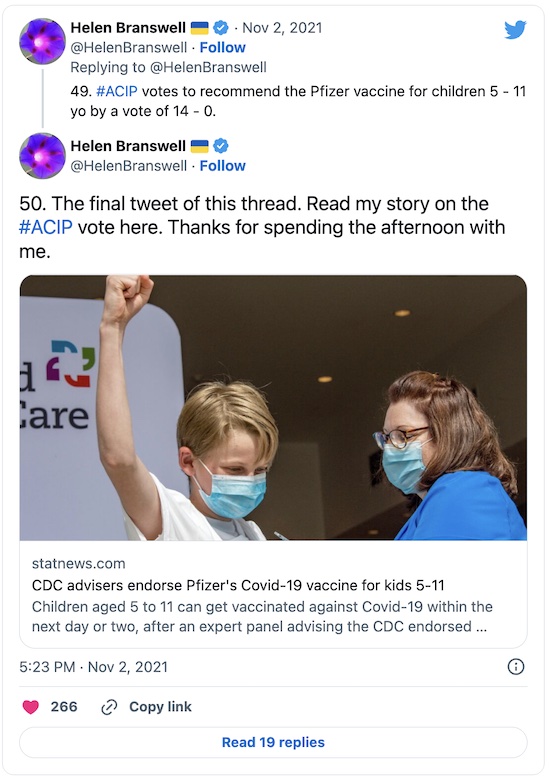
Gestae Commentaria
Comments for this post are closed pending repair of the comment system, but the Email/Twitter/Mastodon icons at page-top always work.